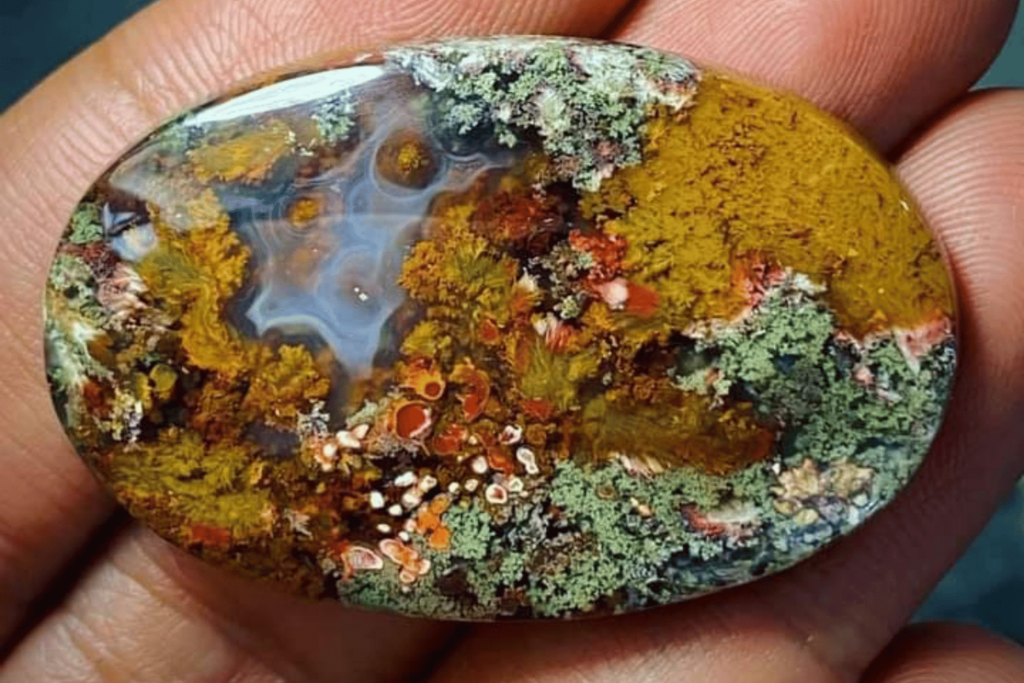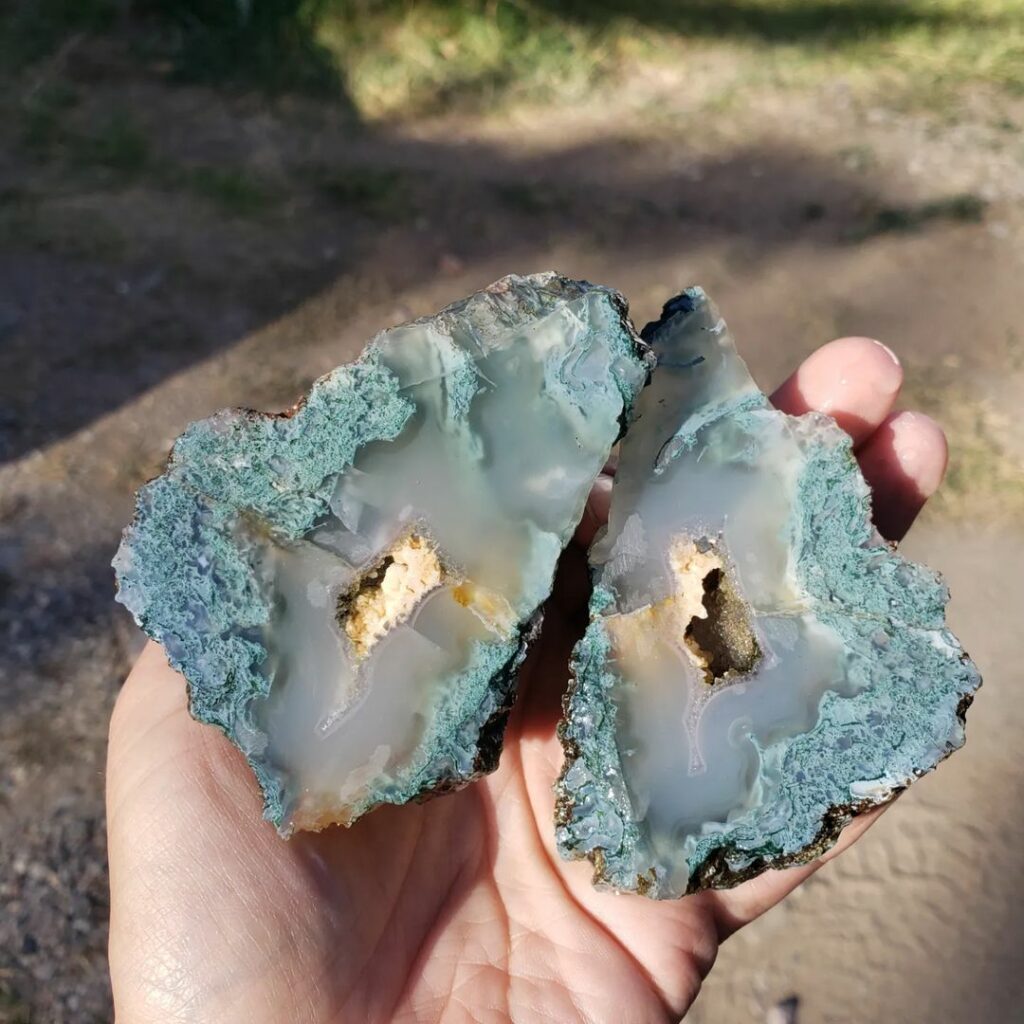Moss agate is a beautiful form of chalcedony, not always banded, that contains dendritic crystals which form a moss-like filament contained within. The coloration varies widely, but it’s generally green or orange due to the variation of minerals that are contained inside. It’s also fairly common… if you know where to look!
So, let’s take a closer look at the best locations to find moss agate, at least here in the United States.
What Exactly is Moss Agate?

Moss agate is the trade name for chalcedony which includes dendritic mineral formations. These dendritic inclusions have a high resemblance to moss…as the name suggests.
Chalcedony itself is a form of silica, comprised of interlocking crystals of quartz and its polymorph moganite. These crystals are so small they’re almost impossible to see, it generally takes a thin slice and an electron microscope to explore the structure.
The inclusions that give it the “moss-like” appearance are either oxidized mineral salts or chlorides depending on the exact place of formation.
As you might expect, different minerals lead to different colors, although all moss agates share the same strange, fluffy-looking inclusion pattern.
When we think of agates, we usually think about the beautiful banding that’s associated with so many agates. But when it comes to moss agate, it isn’t necessarily always banded. And as a matter of fact, it’s one of the best rocks to point out that the definition of agate has moved far beyond its traditional definition of simply being colored bands in chalcedony.
While moss agate can be found in many, many different locations around the world, here are a handful of places that are known for producing many beautiful moss agate specimens.
1. Yellowstone River, Montana

Montana Moss Agate is a famous variation of moss agate, exclusively found along the Yellowstone River. This form of agate is generally a translucent white or orange and sports dendrites that are red to black. In this case, the reddish moss is formed by oxidized iron, while the black spots result from the formation of iron oxide in the chalcedony base.
They’re generally found as small, irregularly shaped nodules in the river. Since they lack some of the more intricate patterns it can take a bit of time to learn how to identify them, so I’d suggest looking at some rough online before you go hunting.
Until recently, collecting from the Yellowstone River didn’t require anything special. As of July 2023, however, you’ll now need to apply for a conservation license with the state of Montana to be allowed to collect legally. As always, double-check regulations before you head out to make sure you’re not falling afoul of any other laws.
2. Maury Mountains, Oregon

While many people love the look of Montana Moss Agate, it may not click for those who prefer more colorful specimens. Oregon has an answer to that, with the brightly colored and heavily included Maury Mountain Moss Agate. Found in Deschutes National Forest, it can have incredible coloration and it’s one of my favorite varieties of the stone.
The material from Maury Mountain is known for its striking collection of colors. Often green, red, and orange will all vie for your attention within a single piece of stone, often highlighting veins of translucent light blue chalcedony. It’s an amazing material overall, only comparable to a few other places in the world.
Due to its remote location and high altitude, this area is closed for much of the year due to snow. It’s probably best to visit in spring when you can enjoy both your stones and the local wildflowers. While no permit is required, the stone is intended only for use by individuals and not as part of a commercial operation. It’s worth taking a look at the website if you think that you might be interested in finding your own.
3. California Beaches (San Francisco to San Diego)

I’ve managed to find quite a bit of moss agate in my old stomping grounds. Coming from the Central Coast it was a fairly common find in the beaches ranging from south of San Luis Obispo to south of Santa Barbara. While it’s not a guarantee, the rockhound with a discerning eye can find all kinds of goodies where the beaches get rocky.
Farther north is the aptly named Agate Beach, near San Francisco, which is known to contain quite a bit of moss agate, among other types. In general, the vast majority of moss agate that I’ve found in these areas consists of translucent chalcedony with orange moss, although green creeps in there sometimes.
Collecting on beaches in California is legal, so a quick day trip is ideal. Your best bet is to look along the surf line, where new rocks wash up and are wet so that you can see them better. Just be careful which beach you’re on and how deep you go, some of these places have nasty rip tides and other hazards that can catch the unprepared if they’re not careful.
4. Blaine County, Idaho

Blaine County is known for its green moss agates. Idaho in general is known for producing some exquisite cryptocrystalline silica formations, with veins of incredible material like “Idaho Sunset Jasper” being unearthed regularly.
Blaine County seems to be your best bet in the state for those who are looking to score some moss agate. The locations noted by the state include many types of agate, but moss agate in particular seems to be found in Blaine County. The area it’s found is north of Muldoon, South of Cary, and along the Little Wood River.
Idaho is a remarkably friendly state for rock collecting, which makes it an even more tempting target. Few permitting requirements are in place and collecting from public locations is explicitly protected. Just take a look at their site, they have one of the best-organized pages for rockhounding out of any state.
5. Escondido Canyon Road, California
If you’re already in the Santa Barbara or LA area, then Escondio Canyon is a great place to take a look for some moss agate. It’s not as common as it used to be, but there are still pieces waiting for those with a sharp eye. The canyon itself is west of the town of Acton, but the entire road has deposits of minerals.
The moss agate here tends to be green, and sometimes trends towards being almost more plume-like in appearance. It’s also known for hosting a lot of vugs, generally lined with quartz druzy. It has a unique appearance, although similar are sometimes found on beaches to the West of the canyon itself.
The area houses numerous other minerals, including rare amethyst geodes. If beach hunting isn’t your thing, it’s a good spot to check out while you’re in California. As a former local to the area, however, I’d still rate the rock beaches in the Santa Barabara area as a better spot for collecting but it’s always worth a shot!
- Online rock and mineral club for collectors of all levels!
- Find community with like-minded rock and mineral enthusiasts.
- Monthly Giveaways!
- Free Access to Entire Digital Library of Products (annual memberships)


